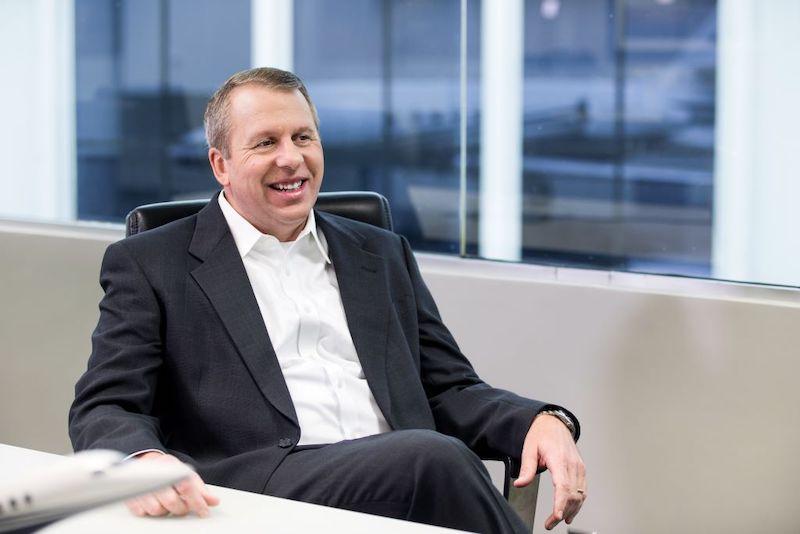
Textron Aviation President and CEO Ron Draper.
Ron Draper joined Wichita’s Cessna Aircraft Co., now Textron Aviation, in 1999 as director of supply chain. After stints at Bell and Textron Specialized Vehicles, Draper returned in 2011. He was named Textron Aviation president and CEO in October 2018.
A good number of new entrants came to the business aviation market since the pandemic started. Where are you finding the market today?
Those new customers have come to the industry and have stayed. And that’s increased the market for us. The market selling airplanes is strong. A year ago, it was white-hot strong. Now, it’s cooled off to a strong market. If you notice, everybody’s backlogs have grown. Three years ago, we had $1.5 billion or $1.8 billion in backlog, and now we have $6.8 billion in backlog. For the first half of the year, book-to-bill has been greater than one.
What are your strongest regions today?
North America—no change there—is our strongest market. Latin America has really been a strong market for us. It has creeped up into probably second place for us. Mexico and Brazil are the two strongest elements within that entire region.
Have corporate buyers returned?
In this cycle of a strong market, initially it was individuals and leisure travelers, and the corporate buyers waited a little longer. Now, they’ve been back for some time.
At the European Business Aviation Convention & Exhibition (EBACE) in Geneva in May, protesters disrupted the static display. What are you expecting at NBAA-BACE?
We did training even before we got to EBACE. We just prepped employees on what to do. I was very happy with our employees. We didn’t want to engage with [the protesters]. We just locked the airplanes and kept folks safe, and it ended up not being that big of an event for us. But it made a lot of news, which is exactly what the protesters wanted. I suppose some people may try that [at NBAA]. They’re trying stuff all over the world—blocking roads, tarnishing monuments, trying to handcuff themselves to airplanes. NBAA is assuring us that security is going to be very high and that they’re doing whatever they can to prevent that. But if somebody wants to do something, then we’ll be prepared to just keep our folks safe and keep our airplanes safe and not engage with them.
What are your biggest challenges?
We’re still all pushing through some supply issues. The capacity of the aerospace supply chain needs to grow raw materials on up. Eventually, the whole country is facing a shortage of skilled labor. And that’s good for workers. That will push wages up. We will go out and compete. We hired 2,000 people this year. We’ll be doing that every year and training lots of folks.
The regulatory process to certify products has slowed. Is European Union Aviation Safety Agency (EASA) validation moving at a faster pace than the FAA? What is the case there?
Validations are too slow, and we continue to discuss that with EASA and the FAA. They’re working on it, and the folks in Washington are all telling us they’re working on it. I was really upset over our [Citation] Longitude validation. It took almost two years. Now, in EASA’s defense, it was in the middle of COVID, and it was hard to get pilots to fly the airplane, and they were short people. We missed sales in Europe because of that. Compared to what we expect, it’s still too slow.
How do you see business aircraft technology evolving until 2035?
Technology is evolving at a rapid rate. There’s this whole part of this industry that’s looking at alternate propulsion sources. Textron is investing in that with eAviation. We’ve got Pipistrel looking at electric and hydrogen. I think you’re going to see more of that come to market in that 12-year timespan. There are limits to that technology, but it’s going to continue to evolve. The technology that is evolving around situational awareness in the cockpit is incredible. You get in brand-new aircraft that we deliver—the avionics, it’s better than airliners have. They avoid; they can land themselves. That’s going to continue. It’s making the job of the pilot so much easier when the plane nearly flies itself. The technology we’re putting in cabin comfort technology is going throughout the product line from nose to tail.
Given the slow ramp-up in sustainable aviation fuel (SAF) production, is it reasonable for business aviation to bet on heavily using SAF in the future?
Production is going to be the constraint on SAF. But SAF is the biggest answer to the sustainability challenge of jet aircraft. We are going to bet on it as an industry. Production and adoption have got to continue to grow. There are other technology bets that we’ll make—alternate sources of propulsion, hydrogen, electric—and all that will evolve separately. I see those technologies first evolving in shorter-use, smaller airplanes. But to go across the ocean with even 10 people in a business aircraft, it’s going to be hard to beat the energy density that’s in jet fuel.
